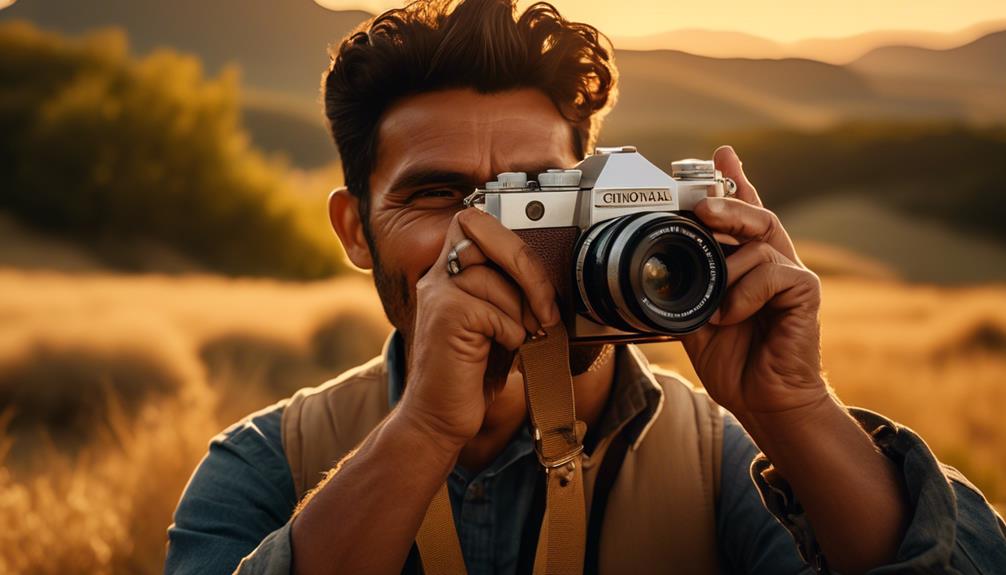Please note this post may contain affiliate links picked by me (Jay) that I have deemed may be of interest or relevant to you the reader of this.
These links do not affect the cost of the thing if you decide to purchase but i may get a little money if you choose to purchase.
For more information on my affiliate link policy click here.
As a photographer, I have always been captivated by the power of storytelling. There is something enchanting about the way a single image can transport us to another time, evoke strong emotions, and ignite our imagination. It is this very essence of storytelling that can take your photography to new heights.
And that's exactly what I want to explore with you in this 4-step guide. So, buckle up and get ready to embark on a journey where you will learn how to choose compelling subjects, plan your visual storytelling approach, capture raw emotion and action, and enhance your images with captivating captions and descriptions. Trust me, by the end of this guide, you'll see your photography in a whole new light.
Key Takeaways
- Narrative imagery has the power to transport viewers into a world where emotions, stories, and visual artistry converge.
- Choosing a compelling subject is crucial as it sets the foundation for the entire photograph, and incorporating storytelling techniques into the selection of the subject elevates photography.
- Planning your visual storytelling approach, including defining the message, utilizing composition and lighting, and incorporating storytelling techniques, can help craft a cohesive visual narrative.
- Capturing emotion and action in your shots by adding movement, adjusting shutter speed, and portraying genuine expressions and moments of vulnerability brings images to life and enhances visual storytelling.
Understanding the Power of Narrative Imagery
Understanding the power of narrative imagery is like unlocking a secret portal that transports viewers into a world where emotions, stories, and visual artistry converge. It's a skill that allows photographers to transcend the boundaries of traditional photography and create images that resonate deeply with their audience. By utilizing storytelling techniques, photographers can transform their photographs into powerful narratives that evoke strong emotions and captivate the viewer's attention.
Emotion in photography plays a crucial role in connecting with the audience on a deeper level. When a photograph is able to evoke emotions, it becomes more than just a visual representation; it becomes a story that speaks directly to the viewer's heart. The power of emotion lies in its ability to make the viewer feel something – whether it be joy, sadness, awe, or any other emotion. By capturing and conveying these emotions through their images, photographers can create a profound impact and leave a lasting impression on their audience.
Utilizing storytelling techniques is the key to harnessing the power of narrative imagery. One such technique is the use of composition to guide the viewer's eye and create a visual story within the frame. By carefully arranging the elements in the photograph, photographers can direct the viewer's attention to specific details and convey a particular narrative. Another technique is the use of light and shadow to create mood and atmosphere. By manipulating light, photographers can evoke different emotions and set the tone for their narrative.
Innovation in photography lies in pushing the boundaries of what's possible and finding new ways to tell stories through imagery. By understanding the power of narrative imagery and utilizing storytelling techniques, photographers can create photographs that not only capture a moment in time, but also tell a compelling story. It's through this fusion of emotions, stories, and visual artistry that photography becomes a powerful medium for self-expression and communication.
Step 1: Choosing a Compelling Subject
When embarking on the journey of creating a compelling photograph, the first step is to carefully choose a subject that will captivate the viewer's attention. Choosing a subject is crucial because it sets the foundation for the entire photograph. It serves as the focal point, the main character in your visual story. To effectively engage the audience and evoke emotions, it's essential to incorporate storytelling techniques into your photography.
One powerful storytelling technique is to create contrast in your subject. By juxtaposing contrasting elements, you can create visual tension and intrigue. For example, a table showcasing a vibrant bouquet of flowers against a background of decaying ruins can evoke a sense of beauty amidst decay, sparking curiosity and emotion in the viewer.
Another technique is to use leading lines to guide the viewer's eye towards the subject. Leading lines can be natural or man-made elements that act as visual pathways, drawing the viewer's attention to the main subject. Imagine a photograph of a winding road leading into a breathtaking sunset. The leading lines of the road create a sense of depth and invite the viewer to explore the image further.
Additionally, the use of color can greatly enhance the impact of your subject. Consider the emotions that different colors evoke and choose a subject that aligns with the desired mood. For instance, a vibrant red apple against a black and white background can create a striking contrast and symbolize temptation or desire.
Incorporating these storytelling techniques into the selection of your subject will elevate your photography and captivate your audience. By carefully choosing a compelling subject, you set the stage for a visually engaging and emotionally resonant photograph. So, embark on your journey with boldness and innovation, and let your subject speak volumes through your lens.
Step 2: Planning Your Visual Storytelling Approach
To truly bring your photography to life and create a captivating visual story, it's essential to carefully plan your approach. By strategically incorporating visual elements and employing storytelling techniques, you can elevate your photographs from mere snapshots to powerful narratives that engage and inspire your audience.
Here are four key steps to consider when planning your visual storytelling approach:
- Define your message: Before you start shooting, take a moment to clarify the story you want to tell. What emotions do you want to evoke? What message do you want to convey? Identifying these key elements will guide your creative decisions and help you craft a cohesive visual narrative.
- Consider composition: Composition plays a crucial role in visual storytelling. Experiment with different angles, perspectives, and framing techniques to enhance the mood and convey your intended message. Pay attention to the placement of your subjects and objects within the frame to create a visually pleasing and impactful composition.
- Use lighting intentionally: Light is a powerful tool in photography. Experiment with different lighting conditions to evoke specific emotions or create a particular atmosphere. Whether it's the warm glow of sunset or the dramatic shadows of a cloudy day, lighting can add depth and dimension to your visual story.
- Incorporate storytelling techniques: In addition to visual elements, storytelling techniques can further enhance your visual narrative. Consider using techniques such as leading lines, repetition, or juxtaposition to guide the viewer's eye and create a sense of continuity and rhythm within your photographs.
Step 3: Capturing Emotion and Action in Your Shots
In order to infuse your photographs with emotion and action, it's crucial to capture authentic moments that elicit a visceral response from your audience. One way to achieve this is by capturing movement in your shots. Movement adds a dynamic element to your photographs and can help convey a sense of energy and vitality. Whether it's freezing the motion of a dancer mid-leap or capturing the blur of a speeding car, incorporating movement into your images can create a captivating visual narrative.
To effectively capture movement, it's important to consider your camera settings. Increasing your shutter speed can help freeze fast-moving subjects, while a slower shutter speed can create a sense of motion blur. Experimenting with different shutter speeds will allow you to find the perfect balance between freezing action and conveying a sense of movement.
Another key aspect of capturing emotion and action in your shots is portraying feeling. Emotion is a powerful tool in photography, as it can evoke strong reactions and create a deeper connection with your audience. To portray feeling in your photographs, focus on capturing genuine expressions and moments of vulnerability. Whether it's the joy on a child's face or the determination in an athlete's eyes, authentic emotions can bring your images to life.
Incorporating a range of emotions in your visual storytelling can also add depth and complexity to your photographs. Consider creating a table to help you brainstorm and plan your shots, mapping out different emotions you want to capture and the corresponding subjects or scenarios. This can serve as a useful guide during your shoot, ensuring that you don't miss any important moments or expressions.
Step 4: Enhancing Your Images With Captions and Descriptions
Enhance the impact of your photographs by adding compelling captions and descriptions that bring your images to life. Captions and descriptions are often overlooked, but they play a crucial role in improving engagement and adding context to your photographs.
Here are four reasons why you should pay attention to this often neglected aspect of photography:
- Tell a Story: Captions and descriptions allow you to tell the story behind your photograph. They provide the viewer with a deeper understanding of the image and help create a connection between the viewer and the subject. By adding a descriptive caption, you can transport your audience to the moment the photograph was taken, allowing them to experience the emotions and atmosphere captured in the image.
- Provide Context: Adding context to your photographs helps the viewer understand the purpose and meaning behind the image. Whether it's a landscape, portrait, or street photography, a well-written caption can provide valuable information about the location, the subject, or the intent of the photograph. Contextual details help the viewer appreciate the photograph on a deeper level, making it more memorable and impactful.
- Engage the Viewer: Captions and descriptions have the power to engage the viewer and encourage them to spend more time with your photograph. A compelling caption can spark curiosity, ignite emotions, or even provoke thought. By engaging the viewer's imagination, you create a stronger connection and leave a lasting impression.
- Promote Sharing and Discussion: Adding captions and descriptions to your photographs not only enhances their impact but also encourages viewers to share and discuss them. When people understand the story and context behind an image, they're more likely to share it with others and initiate conversations. This can lead to greater exposure for your work and create a sense of community among your audience.
Frequently Asked Questions
How Do I Choose the Right Camera for Storytelling Photography?
When it comes to storytelling photography, choosing the right camera is crucial. There are different camera types to consider, each with its own unique features and capabilities. It's important to think about the specific needs of your storytelling style and the type of stories you want to capture.
Additionally, lens selection plays a significant role in enhancing your storytelling images. By understanding the different camera types and selecting the right lenses, you can elevate your photography and create captivating stories that truly resonate with your audience.
Can I Use My Smartphone to Capture Narrative Imagery?
Yes, you can definitely use your smartphone to capture narrative imagery.
While there are some limitations compared to a dedicated camera, smartphones have come a long way in terms of camera technology.
With the right storytelling techniques and a little creativity, you can create compelling and engaging visual stories using just your smartphone.
Don't let the device limit your imagination – embrace the challenge and explore the endless possibilities of smartphone photography.
Are There Any Specific Camera Settings I Should Use to Enhance My Storytelling Shots?
Are there specific camera settings to enhance storytelling shots?
Absolutely! The key is to experiment and find what works best for you.
Adjusting the aperture can create depth and focus on the subject, while playing with shutter speed can capture motion.
Don't forget about ISO, which controls the camera's sensitivity to light.
And of course, composition is crucial for storytelling shots.
Remember, it's not just about the gear, but how you use it to tell your unique story.
How Do I Determine the Best Composition for My Visual Storytelling?
When it comes to visual storytelling, determining the best composition is key. By using composition techniques, you can enhance the impact of your photos and captivate your audience.
It's all about finding the right balance, framing, and perspective to convey your story effectively. Experiment with different angles, leading lines, and rule of thirds to create dynamic and engaging compositions.
What Are Some Tips for Effectively Conveying Emotions Through Photography?
When it comes to conveying emotions through photography, there are a few key techniques that can make all the difference.
One important aspect is lighting. By using light strategically, you can create a mood and evoke specific emotions in your audience. Experiment with different lighting setups and angles to capture the desired emotion in your shots.
Additionally, composition and framing play a crucial role in expressing emotions. Be intentional with your choices to effectively convey the desired feelings in your photographs.
Conclusion
So next time you pick up your camera, remember that it's not just about capturing beautiful images, but about telling a story.
By choosing compelling subjects, planning your approach, capturing emotion and action, and enhancing your images with captions, you can take your photography to the next level.
Let your creativity flow and watch as your photos come alive with narrative imagery.
It's time to make your audience feel like they're a part of the story.


